Categories: Sharing experience, Electrician Secrets, Electrician at home
Number of views: 230598
Comments on the article: 22
What you need to know when installing an RCD and grounding device in an apartment or private house
 Attention!!!
Attention!!!
No need to use RCD or difavtomaty with electronic control, for example, IEK AD 12, IEK AD 14 difavtomats, when the phase or neutral conductor breaks, the power of the electronic control circuit is de-energized and the differential protection stops working. There is a diffrel with an electronic control circuit in which, in the event of a power failure, the consumer switches off in the likeness of a starter. To connect the consumer after resuming power, you must manually turn on this type of diffrel. This type of differential switch can be used to power electrical appliances where it is dangerous to re-supply voltage after a power failure.
With wrong done grounding can be more dangerous than without grounding !!!
Grounding without an RCD or grounding is prohibited !!!
How to connect the RCD properly, see here: RCD connection diagram
Attention!!!
Do not connect the ground terminals of outlets and electrical appliances protected only by circuit breakers that protect only wiring from short circuits in the phase-neutral and phase-phase circuits to natural, artificial and especially home-made grounding. You expose yourself and others to mortal danger. Automata are triggered only by currents many times higher than the nominal value of the automaton. Natural, artificial and especially home-made grounding in the vast majority of cases has a resistance that cannot create such currents and, accordingly, carry out a protective shutdown of automatic machines within 0.4 seconds normalized by safety.
For example, if the neutral grounding at the substation, according to the rules, is 4 Ohms, taking into account repeated grounding and your grounding is also 4 Ohms and a breakdown occurs in one of the electrical appliances, then on all grounded housings of electrical appliances connected to the ground, through protective grounding conductors, a dangerous potential will appear 110 volts. If the resistance of your grounding is more than 4 Ohms, the dangerous voltage on the cases of electrical appliances will be even greater.
For example, in a widespread circuit breaker with a characteristic of 16 amperes, the current to ensure a safe shutdown time of 0.4 seconds should exceed the circuit breaker rating by 5-10 times, that is, for a reliable shutdown in 0.4 seconds, the current passing through the circuit breaker should not be less than 160 amperes.
If the resistance at the substation and local grounding is 4 Ohms, then the current with a single-phase short circuit to ground through this machine will be I = V / R, 220 volts / (4 Ohms of the substation ground + 4 Ohms of local ground) = 27.5 amperes, this is taking into account the resistance of the line itself. If you take them into account, the current will be even less. The C16 machine will not shut off from a current of 27.5A in 0.4 seconds, a shutdown will occur in about 40-180 seconds from the thermal protection of the machine overload. All these 40-180 seconds on the conductive housings of electrical appliances and other electrically connected objects will be, although less than 220 volts, but a dangerous potential. Also, all these 40-180 seconds, the wiring must withstand a current of 27.5A, so that there is no fire.
To achieve grounding resistance even 4 Ohms with three pins, especially driven in the form of a triangle, is very problematic.
Now we calculate what the total grounding resistance should be, so that through the C16 circuit breaker current flows 160 amperes and the circuit breaker shuts down in 0.4 seconds. R = V / A, 220 volts / 160 amperes = 1.375 Ohms, even professionals with experience and devices are not always able to achieve such a total resistance at the substation and local grounding. Automatic machines C25, C32, C40, etc.will not work at all with a total ground resistance of 8 ohms at the substation and local.
Attention!!!
Do not connect the ground outlet of sockets, electrical appliances, metal housings of electrical appliances to pipes and third-party conductive objects of the building.
In the event of a breakdown on the case in an electrical device connected to a pipeline or other external conductive object, the machines may not work for many reasons. Under the voltage of the network will be all electrically connected conductive objects, including in neighboring apartments and houses. As a result, a massively deadly electric shock and fire hazard are inevitable!
At any time, a grounded, nullified pipe may cease to be such, for example, when repairing pipes or in place of threaded joints due to corrosion. Nowadays, plastic pipes are being used more and more, so pipes cannot be a natural grounding, much less a protective conductor.
Some incompetent publications, including on the sites of companies licensed for electrical installation, recommend such deadly and criminally responsible pseudo-protection as the use of pipes as natural grounding or grounding, and the rest the vast majority of publications are re-publication of these publications by people poorly or not at all understanding nothing in electrics.
With centralized heating, water and gas supply in a private house, I would recommend putting plastic couplings in the gap of metal pipes at the entrance to the site or, in extreme cases, at the entrance to the house household electric boilersto protect yourself from the grief of grounding workers.
Wrong done grounding with a neutral break, it is deadly, even if there is an RCD !!!
Attention!!!
Do not connect the ground connection of electrical outlets, electrical appliances with this type of output, and metal housing of electrical appliances to a neutral electrical wire in homes with two-wire wiring, that is, do not nullify the ground connection of outlets and electrical appliances. Some make such a deadly mistake by passing a wire into a shield from the "earthen" terminal of the outlet or electrical appliance and there they nullify or, even worse, connect the "earthen" terminal terminal to the neutral wire with a jumper.
At any moment, at any place, a neutral wire break can occur, it is usually remembered by the burning of almost all the electrical appliances included in the network, the phase and neutral will be mistakenly interchanged, the wires will overlap on the overhead lines, after which a dangerous voltage distortion of the network will appear on the zeroed cases of electrical devices .
The PUE describes the grounding of the conductive surfaces of electrical installations, which include elevators, pumping stations, transformer substations, building entrance boards that are serviced by qualified personnel, and not household electrical appliances with single-phase power. According to paragraph of Russian PUE 7 1.7.132 It is not allowed to combine the functions of the zero protective and zero working conductors in single-phase and direct current circuits.
7.1.45. The choice of the cross-section of the conductors should be carried out in accordance with the requirements of the relevant chapters of the PUE. Single-phase two- and three-wire lines, as well as three-phase four- and five-wire lines when supplying single-phase loads, must have a cross section of zero working (N) conductors equal to the cross section of phase conductors. Three-phase four- and five-wire lines when feeding three-phase symmetrical loads must have a cross section of zero working (N) conductors equal to the cross-section of phase conductors, if the phase conductors have a cross section of up to 16 mm2 for copper and 25 mm2 for aluminum, and for large cross sections - at least 50 % cross section of phase conductors. The cross-section of PEN conductors must be not less than the cross-section of N conductors and not less than 10 mm2 for copper and 16 mm2 for aluminum, regardless of the cross-section of the phase conductors.The cross-section of PE conductors should be equal to the phase cross-section for the latter to 16 mm2, 16 mm2 for the phase conductors from 16 to 35 mm2 and 50% of the phase conductors for large cross-sections. The PE section of conductors not included in the cable should be at least 2.5 mm2 - in the presence of mechanical protection and 4 mm2 - in its absence.
The photographs show floorboards of residential multi-apartment buildings, with two wired apartments, in which there is no PEN conductor that meets modern standards for the cross-section of conductors, and even less PE conductor. Only the PEN conductor, which is shabby from time to time, which in some boards has gaps forbidden, even by the old rules, on each floor, is made of an aluminum wire with a cross-section of about 6 mm, which does not comply with modern standards of the cross-section, to which the neutrals of the meters and the shield itself are not connected securely and accordingly, it cannot perform protective functions. The neutrals of the apartments are connected directly to the meters. Also, there is no connection to the ground loop of the building.
Maybe the photos will convince you not to get lost, it’s not clear where.
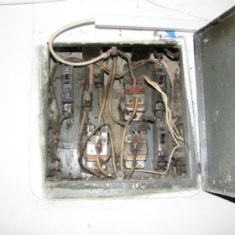
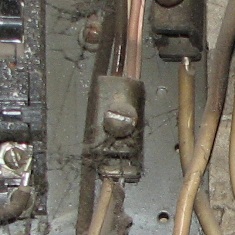
Shield 4 floors of a 9-storey building.
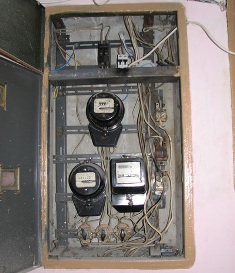

The shield on the 1st floor of a 9-story building, it is clearly seen that the neutral aluminum wire with a cross section of about 6 mm does not directly touch the bracket welded to the shield, but connects to it through two plates, it breaks, although the design of the clamp allows you to start a solid wire.
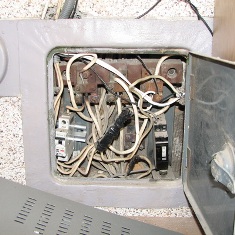

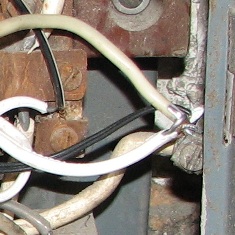
The shield of 2 floors of a 9-storey building, the neutral of this and all the upper floors is connected through an incomprehensible connection in the electrical tape. also on the upper right part of the photo you can see that some strange incomprehensible neutrals are connected on this floor.
To protect against electric shock in houses with two-wire wiring, especially in the presence of children, boilers, a jacuzzi, washing machines, microwave ovens, dishwashers, etc., the only correct option is to install a 10 mA RCD first after an opening machine or apartment traffic jams.
The most optimal option is to put an RCD of 10 mA after the automatic machine of each group, and to install duplicate RCD 30 mA after the introductory machine.
It would not hurt to replace a pair of existing plugs or a single-pole single-pole circuit breaker with a two-pole circuit breaker with characteristic B, which would simultaneously turn off the phase and neutral. Or make a billboard and divide and protect different consumers with avatoms with lower denominations.
Attention!!!
If the three-wire wiring has already been done and connected, and the grounding is missing or not yet done, disconnect the protective conductor from all outlets, chandeliers and other electrical appliances and the protective bus in the shield, and insulate. In the event of a breakdown in one of the devices under a dangerous network voltage, through the protective conductor, there will be all the conductive cases of electrical appliances, this is especially dangerous in the absence of an RCD. Also, when protective conductors are connected and there is no grounding, the static and capacitive currents of all connected electrical appliances are summed up through the protective conductor, as a result of which a fatal electric shock is possible with healthy electrical appliances. Therefore, before disconnecting the protective conductors, you must remove all plugs from the sockets, completely turn off the electricity.
RCDs primarily protect against electric shock, although the rules interpret RCDs as additional protection, the machine protects the wiring from short circuits, grounding removes static, capacitive currents of electrical appliances and, not completely, reduces the dangerous potential. Therefore, the cost of RCDs does not go to any comparison with human life. A friend of mine died from an electric shock in the bathroom!
Those who do not understand anything at all in an electrician need to find an adapter with a built-in difavtomat that is plugged into an outlet, and the plug of the appliance is included in it, though it has a difavomat for a leakage current of 30 mA and a protective current of 16A. The use of such an adapter in any case greatly increases electrical safety when using any electrical appliance.
Installing sockets, switches, electrical appliances in the bathroom without using a 10 mA amp RCD is deadly!
Look on the topic: What determines the resistance of the human body to the passage of electric current
Attention!!!
Do not connect the neutral wire on your own initiative to your ground, that is, do not re-ground the neutral wire at the input and, accordingly, neutral the electrical appliances. The re-grounding of the supply lines should primarily be handled by the power transmission organization. No need to improve the quality of electricity to neighbors at the cost of their own safety! In the event of emergencies on the supply line, a neutral wire break, phase and neutral reversal, overlapping wires on overhead lines, your earthed neutral can become the only neutral of all houses through your ground. In handicraft performance without observing the rules and relevant qualified tests, grounding is unlikely to withstand this and can burn out, at best causing a fire, and if it does, then there is no guarantee that it will provide safe touch voltage on open conductive surfaces. In this connection, it is inevitably fatal and criminally liable for violating the rules of operation of electrical installations, electric shock through electrically connected open conductive surfaces and the risk of fire!
If you do neutral grounding again when powered by overhead lines, it is best to do this at the point of removal from the supply line, and to call an authorized specialist for connection. In the event of a break in the neutral line made by the "professionals", and beyond it, perhaps, the fencing of your artisanal re-grounding will minimize the possibility of a house fire. And consider the quality of execution and the cross-section of the conductors must withstand the load of all consumers connected to the transformer substation for a long time, in case of neutral burn-out on the line. On the pole from which the branch is going and re-earthed the neutral, hang at least 2 plates "Dangerous voltage!" and fenced if possible.
See also at bgv.electricianexp.com
:

# 21 wrote: Vlad | [quote]
Here, one commentator expressed an amazing story about a friend who saved an RCD in the basement when changing phase-zero .... But he forgot to add that the RCD will work if it is strictly connected to these phase-zero, and if it is moved in places, it does not work. And within the meaning of the main article, I agree. RCD must be installed without any improvised grounding conductors there, the current that passes through the body to the ground is enough for it. I say how. Just need to take into account that the RCD will not save when a zero break. The phase in this case appears on the entire line.